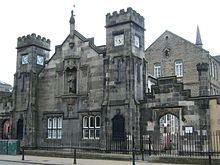Andrew Bell (educationalist)

Andrew Bell
Life and work

Andrew Bell was born at
In 1774 he sailed to Virginia as a private tutor and remained there until 1781 when he left to avoid involvement in the war of independence. He returned to Scotland, surviving a shipwreck on the way, and officiated at the Episcopalian chapel in Leith. He was ordained deacon in 1784 and priest in the Church of England in 1785.[2][3]
In February 1787 he went out to India and went ashore at
In Bell's adaption of the Madras, or
He was a careful man and accumulated considerable wealth. In August 1796 he left India because of his health and published an account of his system, which started to be introduced into a few English schools from 1798/99, and he devoted himself to spreading and developing the system. He served as a priest in Edinburgh for a short time and married Agnes, daughter of Dr George Barclay in December 1801. He was then appointed rector of St Mary's Church, Swanage in Dorset and established a school there to teach straw-plaiting to girls and also using his system to teach infants. He and his wife adopted the new discovery of vaccination for smallpox and successfully vaccinated many people in the district. However his marriage was unsuccessful and a decree of judicial separation was granted in 1806.[6]
Another educationist, Joseph Lancaster, was promoting a similar but not identical system and their differences developed into a major and continuing dispute. Unlike Bell's schools, those established by Lancaster were not committed to the Church of England.[7]
Bell received powerful support from the Church and his system was adopted in army schools and the
Bell was a fanatical enthusiast for his system and an intolerant man. He was difficult to deal with and hard to work under. Nevertheless, he always got on well with children.[9]
Death

He retired to Lindsay Cottage in Cheltenham, a wealthy man, at the age of 75 and died at home, aged 78, on 27 January 1832. He was buried in Westminster Abbey with a monument designed and carved by William Behnes.[10]
His great fortune was bequeathed almost entirely for educational purposes but with what many considered unreasonable conditions attached.[11] As well as Madras College, St Andrews, Bell also left money for schools in Inverness (Faraline Park, now Inverness Library), Glasgow, Edinburgh, Leith (Commercial Street) and Cupar (now called Bell Baxter High School, formerly Madras Academy). £10,000 was also given to the Royal Naval School.
His system did not survive for long after his death. It needed close and enthusiastic supervision and small classes and was only really useful when funds were sparse and teachers in very short supply.[12]
See also
- Bell-Lancaster method
- Benjamin Jesty
- Learning by teaching (LdL)
Notes
- ISBN 978-0-902198-84-5. Retrieved 22 December 2011.
- ^ a b Blackie 901
- ^ "Bell, Andrew (1785 - 1785) (CCEd Person ID 4499)". The Clergy of the Church of England Database 1540–1835.
- ^ Blackie 903
- ^ For Bell's early account of his system see: Andrew Bell (1808). The Madras School: Or, Elements of Tuition: Comprising the Analysis of an Experiment in Education. London.
- ^ Blackie 904
- ^ Blackie 903-4
- ^ Blackie 904-5
- ^ Blackie 905 & throughout
- ^ Dictionary of British Sculptors, 1660-1851, Rupert Gunnis
- ^ Blackie 905
- ^ cf. Blackie 905
References
- Bell, Andrew: An analysis of the experiment in education, made at Egmore, near Madras (London, 1807: Available on Google Books)
- Bell, Andrew: An Experiment in Education Made At The Male Asylum of Madras. Suggesting A System By Which A School or Family May Teach Itself Under the Superintendance Of The Master Or Parent. By The Rev. Dr.Andrew Bell. 1797- Primary Source Edition [Available on Amazon.com]
- Bell, Andrew: Mutual Tuition and Moral Discipline: Or, Manual of Instructions from Conducting Schools Through the Agency of the Scholars Themselves: For the Use of Schools and Families. with an Introductory Essay On the Object and Importance of the Madras Sysetem of Education. 1823 Primary Source Edition [Available on Amazon.com]
- Blackie, Jane. "Bell, Andrew". doi:10.1093/ref:odnb/1995. (Subscription or UK public library membershiprequired.)
- Macdonell, George Paul (1885). . In Stephen, Leslie (ed.). Dictionary of National Biography. Vol. 4. London: Smith, Elder & Co.
- Chisholm, Hugh, ed. (1911). . Encyclopædia Britannica. Vol. 3 (11th ed.). Cambridge University Press.
Further reading
- John Miller Dow Meiklejohn(1881), An Old Educational Reformer: Dr. Andrew Bell
- Chambers, Robert; Thomson, Thomas Napier (1857). . A Biographical Dictionary of Eminent Scotsmen. Vol. 1. Glasgow: Blackie and Son. pp. 196–199 – via Wikisource.
